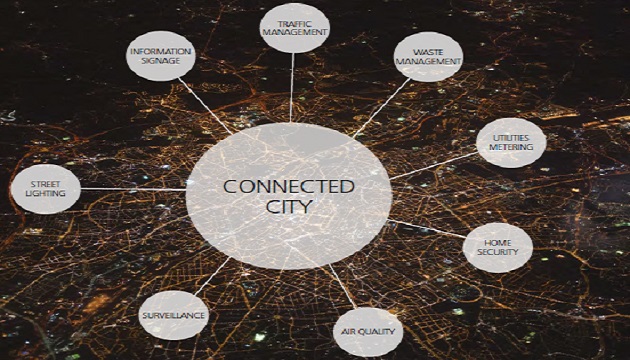When it comes to smart cities, one size does not fit all. Geographic, cultural, financial, and technical considerations that vary from city to city dictate how technologies can be applied to the smart city concept. Ultimately, however, the end goal is always the same: to use connectivity, the cloud, and data analytics – in other words, the Internet of Things (IoT) – to enhance the lives of a city’s residents. This can translate to anything from reducing traffic congestion and pollution to optimizing supply of energy and water, from improving waste management to making urban infrastructure maintenance more efficient.
In all of these areas, the IoT plays a central role. It enables data collection from an almost infinite variety of sensors and other sources, the processing of that data locally or in the cloud, and the initiation of actions based on information gleaned from it. From smart meters to smart parking spaces, every facet of the city can be connected to the cloud and prefixed with the word “smart,” promising optimized flows of materials, energy, and people within cities.
But what does it mean when every street light, garbage can, parking lot, traffic light and power, water, and gas meter is connected to the cloud, along with every single appliance in every single building, factory, and store? The density of devices, or nodes, in the resulting urban IoT calls not only for smart, affordable, and energy efficient connected devices, but also for the right choice of network technologies and topologies.
A case for mesh networks
One example of such a smart topology are mesh networks. Rather than having each node link up to the cloud directly, mesh networks connect nodes to each other. When brought together in a mesh network, smart street lights, for example, can share data on their position, the ambient light around them, and the presence of people or vehicles, allowing the entire network of street lights to intelligently orchestrate its activity. The result is a safer and more energy‑efficient city.
Capillary networks, in which a mesh network is connected to the cloud via a gateway – typically using low bandwidth cellular technologies such as Low Cat LTE – are another. Returning to the example of smart street lights, capillary networks let local authorities track the status of an entire network of street lights on the cloud, visualize the collected data on an online dashboard, and control the street lights from afar.
Capillary and mesh networks are good options when data throughput is low and latency is secondary. They offer extensive geographical coverage, even into otherwise hard to reach locations, since data can flow across the network from node to node as long as internode distances kept short. During the monitoring of local events, seamless wireless connectivity between every single node can help reduce the number of connections to the cloud, keeping power consumption low, increasing the battery life of each device, and thereby decreasing maintenance. And the networks scale easily, in particular in flat mesh networks with self‑forming and self‑healing architectures, making it straightforward to add nodes as demands on the network evolve.
The right hardware
Implementing such networks can be challenging, with interoperability between nodes, coverage, scalability, and, importantly, security being the main issues. The effort can be reduced with the right hardware.
Our NINA Bluetooth low energy module series supports Bluetooth Mesh, Thread, and other proprietary mesh technologies via our partners, including Wirepas Mesh, allowing you to develop mesh solutions for smart city (and other) applications.
And our SARA cellular module series makes it easy to connect your mesh network to the cloud – for example via Narrowband IoT or LTE Cat M1 – regardless of where you are.

